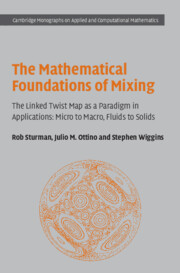 The Mathematical Foundations of Mixing
The Mathematical Foundations of Mixing Book contents
- Frontmatter
- Contents
- Preface
- Acknowledgments
- 1 Mixing: physical issues
- 2 Linked twist maps: definition, construction and the relevance to mixing
- 3 The ergodic hierarchy
- 4 Existence of a horseshoe for the linked twist map
- 5 Hyperbolicity
- 6 The ergodic partition for toral linked twist maps
- 7 Ergodicity and the Bernoulli property for toral linked twist maps
- 8 Linked twist maps on the plane
- 9 Further directions and open problems
- References
- Index
8 - Linked twist maps on the plane
Published online by Cambridge University Press: 03 February 2010
- Frontmatter
- Contents
- Preface
- Acknowledgments
- 1 Mixing: physical issues
- 2 Linked twist maps: definition, construction and the relevance to mixing
- 3 The ergodic hierarchy
- 4 Existence of a horseshoe for the linked twist map
- 5 Hyperbolicity
- 6 The ergodic partition for toral linked twist maps
- 7 Ergodicity and the Bernoulli property for toral linked twist maps
- 8 Linked twist maps on the plane
- 9 Further directions and open problems
- References
- Index
Summary
In this chapter we discuss the conversion of results for toral linked twist maps into results for planar linked twist maps. These systems seem more directly applicable to fluid mixing, but introduce new technical difficulties in the mathematics.
Introduction
In Chapter 2 we discussed the connection between linked twist maps and fluid flow, and observed that linked twist maps on the plane arise naturally in a number of existing experimental constructions, such as blinking flows and duct flows. However the extension of the results for toral linked twist maps to planar linked twist maps is not entirely straightforward. The situation for toral linked twist maps is relatively simple (at least in comparison to linked twist maps on other objects) because we can express twist maps in two independent directions in the same (Cartesian) coordinate system. The situation for planar annuli is more complicated.
As in Chapter 4, annuli in the plane and twist maps on such annuli are naturally described in polar coordinates. However, to create a linked twist map we require a pair of annuli with different centres. There is no simple coordinate system which then describes twist maps in both annuli. We therefore require additional transformations to move from one coordinate frame to another.
The following work in this chapter is mainly due to Wojtkowski (1980). This work predates Katok et al. (1986) by some six years, and so the author could not appeal to the Katok–Strelcyn version of Pesin theory for systems with singularities.
- Type
- Chapter
- Information
- The Mathematical Foundations of MixingThe Linked Twist Map as a Paradigm in Applications: Micro to Macro, Fluids to Solids, pp. 217 - 239Publisher: Cambridge University PressPrint publication year: 2006


